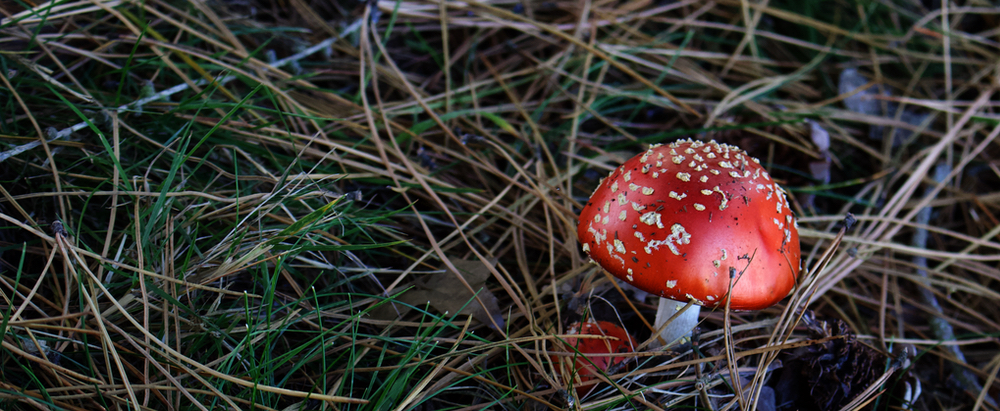
Making Sugar from Homegrown Sugar Beet
Hello friends,
As you may know by now I like growing new varieties of fruits and vegetables, and the more unusual the better. Over the past couple of years I've grown Sugar Beet, with the hope to try and process my own sugar. Here in New Zealand we get all our commercial sugar from sugar cane grown in Queensland, Australia, but elsewhere in the world (including the USA) sugar is made from sugar beet.
Up until this year it was possible to buy sugar beet seeds from Kings Seeds, but they no longer sell any at this time. Sugar beet are very closely related to beetroot, and are grown in the same manner. It's best to sow them in later winter/early spring directly into the ground. Each "seed" in the packet is actually made up of 8 seeds, which grow very close to each other. After the seeds have germinated and come up from the soil, it's a good idea to pull out any that are too close together, and replant them further apart to maximise your sugar beet crop.
After that, the sugar beet plants are very easy to take care of. I watered them infrequently over the hot summer months, and come autumn, after the first frost, they're ready to harvest. As with parsnips and carrots, sugar beet are sweeter after a frost. With a garden fork it's pretty easy to pull them out of the ground. The top of the plants look like beetroot plants, and the roots of the plants look similar to parsnips.
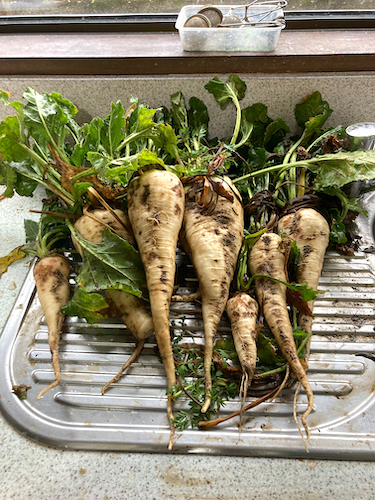
Once in the kitchen, the first step is get all the dirt off the roots by washing and scrubbing, and after that it's time to peel the sugar beet roots themselves. We just used a regular vegetable peeler, and then cut the tops off the sugar beet roots with a sharp knife.
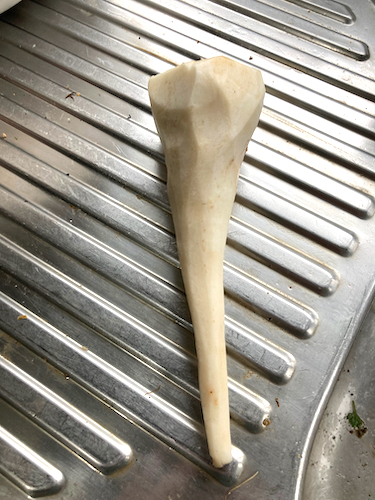
The next step is to prepare the sugar beets for grating using a food processor. We cut them into smaller chunks that would be easy to feed down the shute of the food processor. With a food processor grating the sugar beet on a rough setting took only minutes, but doing it the old fashioned way by hand took an hour (I did this in previous years). At this stage of the process we had 2 kg of sugar beet roots.
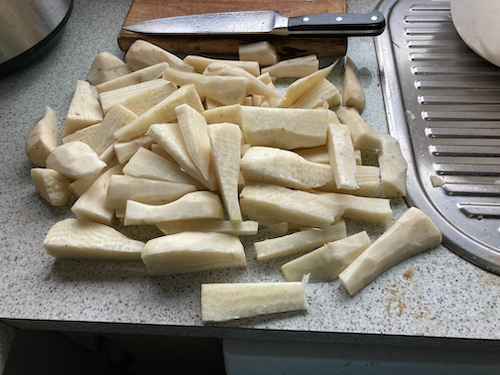

With this done, it was time to cook the sugar beet. The first year we made sugar from sugar beet we used this blog post as a guide. But this method is very labour intensive, and we burnt the sugar from the sugar beet while drying it down.
However, this year, we had a secret weapon, our brand new, handy dandy, steam juicer. Before the harvest, I had spent weeks coming up with this idea of extracting the sugar from the sugar beet using the steam juicer. Steam juicers are great for extracting juice from fruit and veges using the power of steam. You put your fruit or vegetable of interest in the top compartment of the steam juicer, add water to the bottom compartment of the steam juicer, and turn on the stove. The water heats up in the bottom compartment, and the steam rises up to the top compartment through a whole in the middle compartment. The steam cooks and softens the fruit or vegetable in the top compartment, and the cooled juice drops into the middle compartment to collect. From there, there is a spout to siphon off the collected juice at the end of the steam juicing. It's an ingenious system of juicing a big range of fruit and vegetables, and I use it a lot for making blackcurrant juice in summer, and apple juice in autumn. If you're interested in buying one in New Zealand, Netropolitan sells them infrequently when they bring them into the country. I had to wait over a year to get our one.
The steam juicer guide suggested that 1 hour of heating was good for extracting juice from beetroot, so I used that as a guide for steam juicing our grated sugar beet. The sugar beet went into the steam juicer, and an hour later the sugar beet juice had collected in the middle compartment of the steam juicer. After checking the sugar beet in the top compartment, is was soft and cooked.
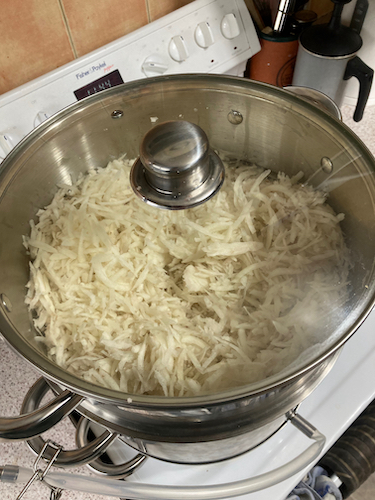
After siphoning off the sugar beet juice in the steam juicer, we filtered it through some cheese cloth to remove any solid bits of sugar beet. The left over sugar beet in the top of the steam juicer was still quite wet, so we also put that through the cheesecloth and squeezed as much juice out of it as we could get. Hubby mumbled something about getting a cider press at this point to make the job easier, but that seemed a little extreme to me...
The thing about sugar beet juice is that it isn't the nice pristine white colour you would be expecting from sugar. Normal sugar is highly processed to remove all the impurities in order to get pretty white sugar that looks the most appealing. Sugar beet juice is a brownish colour, similar to molasses, and without a centrifuge and other commercial processes, it's just not possible to get sugar that is pure white. Since we use our sugar beet sugar in baking and cooking, the brown colour doesn't bother us at all.
The next step in processing the sugar beet to get sugar, is to decrease the volume of liquid in the juice. All the sugar beet juice was transferred into a pot, and it was brought up to a simmer. The more water that comes out of the juice, the more syrupy the juice gets. You need to pay attention to it, otherwise you could remove all of the water, and burn the sugar beet molasses (I know this from experience last year).
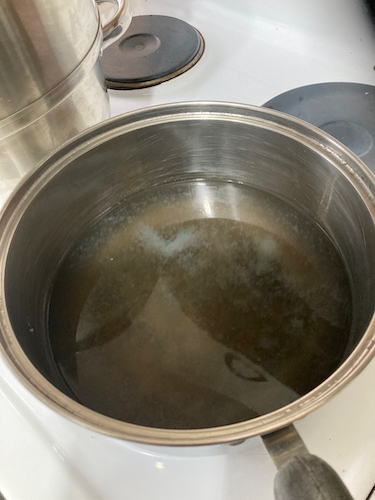
When you get the sugar syrup to a stage you are comfortable at, it's time to take it off the heat. There are two methods at this stage to remove the last of the water, either pour it into shallow trays to dry slowly over time, or bring out the dehydrator, and get it to do all the work for you in a much shorter period of time. I decided to bring out the dehydrator. The aim in the drying is to try and get sugar crystals to form, and the best way to do this is to actually seed the cooled sugar syrup with a sprinkling of sugar crystals. I haven't figured out this step totally yet, so I just got a small amount of sugar and sprinkled it on top the sugar beet syrup.
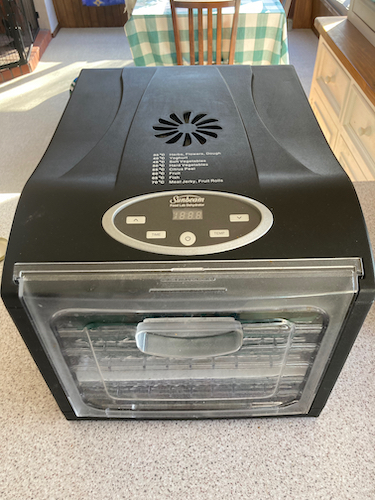
The dehydrator doesn't have an exact setting for dehydrating sugar syrup, so I chose the fruit leather setting which is set to 70˚C. The sugar syrup was poured onto dehydrator silicone sheets with a lip around the entire edge, and put into the dehydrator. After a total of 5 hours, the sugar beet sugar in the trays had dried enough to lift the sugar from the flexible silicone sheets.

The sugar was still sticky in the middle and bottom layers at this stage, so I broke the sugar up into smaller pieces and spread them out evenly over the silicone trays to dry further. After a further 5 hours, the sugar was completely dry. When broken, the sugar cracked.
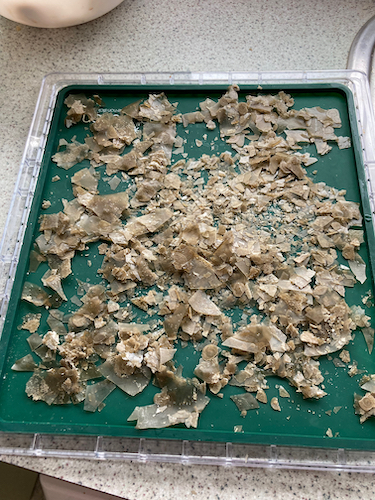
The last step in making sugar from sugar beets is to break the shards of sugar into smaller pieces. At this stage I brought out my Breville Coffee and Spice Grinder and filled it up with the sugar shards, and broke them down into smaller pieces. I use the grinder all the time to process all of our dried herbs and spices, and it has a handy removable stainless steel bowl for cleaning. It is quite often on sale, so no need to buy it at full price if you're after one for yourself.

I repeated grinding all the sugar into smaller pieces until all the sugar shards had been turned sugar.
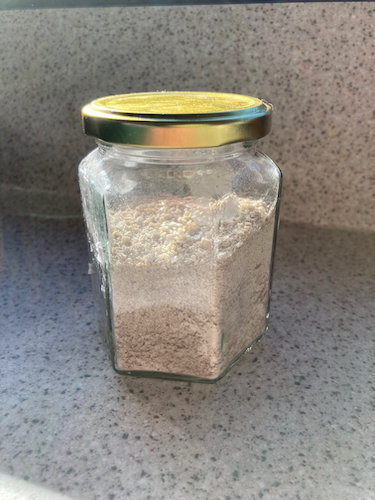
The final weight of the sugar extracted from our sugar beets was 162 grams from 2 kg of roots, which equates to a sugar content extraction of 8.1%. Sugar content extraction in sugar beets can vary anywhere from 12 - 21% according to Wikipedia using commercial processes, so I think that 8% is good for us as home growers. I think we could have gotten the number higher if we had a fruit press like hubby had mentioned, but that is a bit extreme I feel for the average home grower. The other thing to consider is when to harvest the sugar beet. Due to health issues this year, we harvested it later in the season compared to other years. It's possible that some of the sugar beet had been used up already by the plants prior to harvest.
And what does sugar beet sugar taste like? Well, it tastes like sugar, it's nice and sweet, but it has a taste reminiscent of barley sugar. Our plan is to use the sugar in baking our Christmas Cake this year. We did this last year, and no one who ate the cake noticed anything different from previous years.
As for the coming growing season, what is our plan sugar beet wise? Well thanks to some lovely people in some Facebook NZ seed swapping groups, I've been given some sugar beet seeds from their Kings Seeds packets that they still had spare in their stashes. Our plan is to grow these seeds on to develop our own big stash of sugar beet seeds for growing on in years to come. I'll also pass on some of these seeds to other people want to do the same. As sugar beet plants are biennial, it will take two seasons to happen, from there we can grow sugar beet every year and collect more seed.
I hope that you have enjoyed this in explanation of growing, harvesting, and processing of sugar beets to turn into sugar. Feel free to ask any questions on my social media about this, and I'll try to give you answers. I'm also interested if anyone has any suggestions to streamline this process any further.
Have a wonderful day
Julie-Ann
Want to discuss my post? Feel free to chat with me on Instagram or Mastodon.




